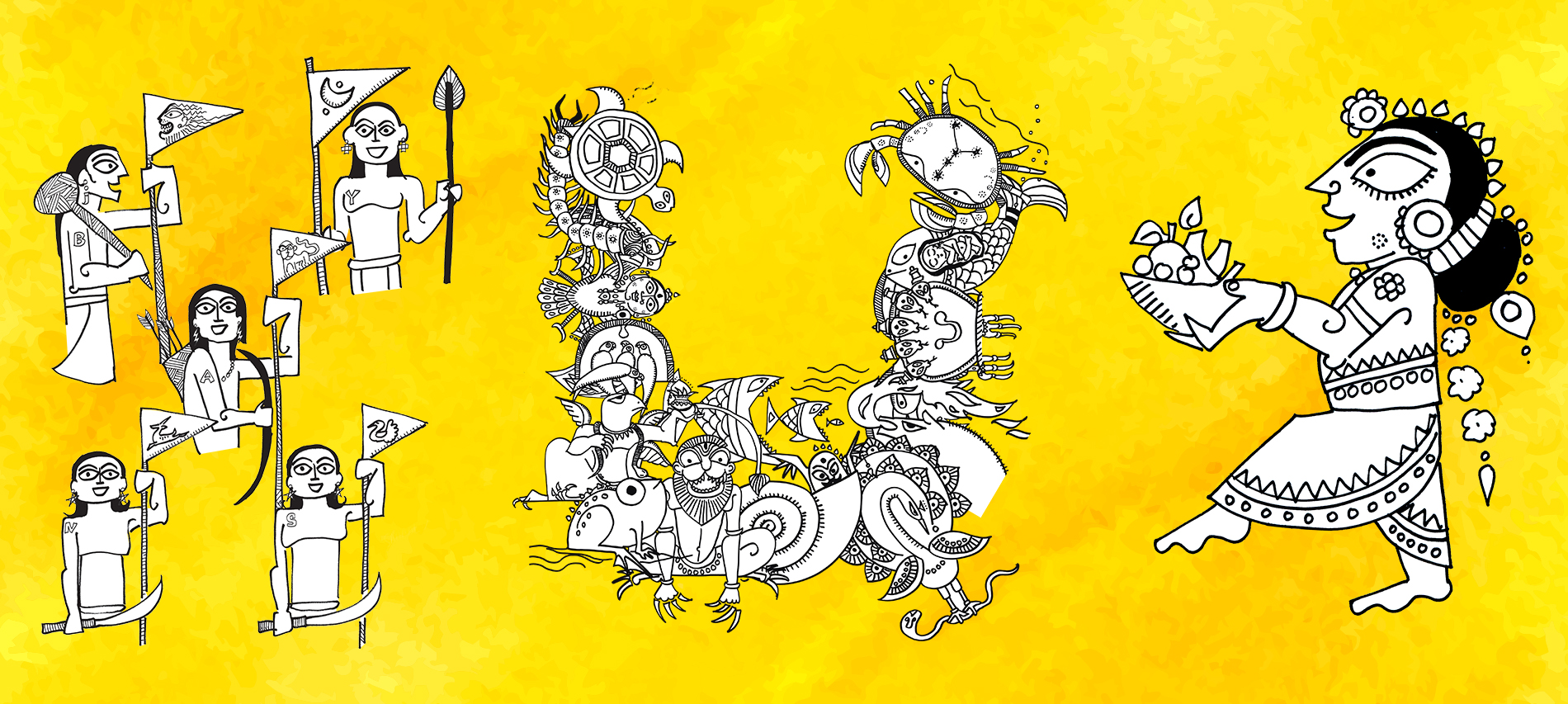Vyasa by Sibaji Bandopadhyay, is a stunning rendition of the beginning of the Mahabharata, the first of a trilogy that sets the stage for the grand battle of Kurukshetra.
Breathing life into the story is illustrator Sankha Banerjee, whose stunning artwork almost gives a cinematic edge to a story that has been retold through generations.
Here’s taking a peek into the sketchbook of Sankha Banejee, the magician at work.
The Epilogue

The servant girl who loved Vyasa

‘City of elephants’ — Hastinapura

Bhishma

Sauti is a dancer story-teller

Another one from the sketchbook

Stunning, don’t you think? Don’t wait to grab your copy now!

Tag: Indian Mythology
‘The Story of Ravana, Ram or Sita?’: ‘The Girl Who Chose’ — An Excerpt
India’s favourite mythologist Devdutt Pattanaik’s ‘The Girl Who Chose’ brings a fresh perspective to what we have commonly known of the Ramayana — the story of Ram.
However, it has largely gone unnoticed that it was the choices that Sita had made which becomes the pivot for the Ramayana.
Here’s an excerpt from Devdutt Pattanaik’s book telling us why the story of Sita is at the heart of all that happens in the epic.
“Once upon a time, there was a man called Ravana, also known as Paulatsya—being the descendent of Rishi Pulatsya from his mother’s side. He was king of Lanka and ruler of the rakshasas, who tricked a princess called Sita, dragged her out of her house in the forest and made her prisoner in his palace. He was killed by Sita’s husband, Ram, the sun-prince. This story is called the Pulatsya Vadham, or the killing of the descendent of Pulatsya.
The story of Ravana’s killing is part of a longer tale called the Ramayana, which tells the story of Ram from his birth to his death. However, in the din of Ravana’s cruelty and Ram’s valour, something is often overlooked—the story of Sita, the girl who chose.
Valmiki, author of the Ramayana, written over 2000 years ago, tells us how Sita is different from Ram and Ravana. Ravana does not care for other people’s choices, while Ram never makes a choice as, being the eldest son of a royal family, he is always expected to follow the rules. But Sita—she makes five choices. And had Sita not made these choices, the story of Ram would have been very different indeed. That is why Valmiki sometimes refers to the Ramayana as the Sita Charitam, the story of Sita.
Do you know what were the choices that Sita had made? Grab a copy and find out now!
'A Very Long Epic': 'The Boys Who Fought' — An Excerpt
When an army of five fights against a battalion of a hundred, what happens? Devdutt Pattanaik’s ‘The Boys Who Fought’ looks at the Mahabharata not as an epic war for revenge, but one for the cause of dharma.
Here’s an excerpt from Pattanaik’s Mahabharata with a twist.
Once upon a time, there was a man called Vyasa. His father was a sage. His mother was a fisherwoman. He was born on a river island, and had a dark complexion.
Vyasa grew up watching animals fight. Then he saw humans fight. And he wondered, what was the difference?
In the forest, the mighty eat the meek. In human society, the mighty can take care of the meek. This is dharma, realized Vyasa. It creates a decent human society.
Inspired, Vyasa wrote an incredible story in 1,00,000 verses, split into eighteen chapters, about the fight between a hundred brothers and their five cousins.
Ganesha, who has the head of an elephant, wrote down Vyasa’s story, which became renowned as the Mahabharata, the great Indian epic, for Bharata is another name for India.
Others called it Bharata Kavya, the song of the Bharatas, for the hundred brothers and their five cousins belonged to the Bharata clan, also known as the Kuru clan, which once ruled over India.

Some people called the story Vijaya, the story of victory, for it describes how the Pandava five, with just seven armies, defeated the Kaurava hundred, with eleven armies, in an eighteen-day-long war.
Vyasa, however, insisted that his epic should be called Jaya, a victory in which no one was defeated. For, in the story, Krishna of the Yadu clan, cousin to both the Pandavas and the Kauravas, reveals a different kind of fight—a greater fight that takes place before weapons are raised on the battlefield, a fight of thoughts and emotions that arises inside our minds and hearts.

Can’t wait to read more? ‘The Boys Who Fought’ is coming soon!

Have You Introduced Your Child to Devdutt Pattanaik’s Mythological Stories with a Twist?
Hailed as one of India’s favourite mythologists, Devdutt Pattanaik’s books introduce us to the world of Indian mythologies and epics with a fun and interesting twist.
Before you wonder how you’ll take on the difficult task of getting your child to remember the countless stories from our epics, let’s look at the wonderful world of some of Devdutt Pattanaik’s books.
Fun in Devlok Omnibus

Do you know the name of the demon with poor memory? Do you know the story of the time Lord Krishna landed at the airport? Have you heard of the big fight between Kama and Yama? Dive right into the amazing world of Devlok with this beautifully illustrated book!
Pashu

In Indian mythology, a fish rescues the world from destruction and a horse can fly high. But where do these animals come from? Why are some of them looked upon with dread, while the rest are worshipped with the Gods and Goddesses? Devdutt Pattanaik unravels the mysteries of the interesting animal world in Indian mythologies in this delightfully illustrated book!
The Girl Who Chose

The epic of Ramayana has been told and retold through generations from the points of view of Ram and Ravana. But little did we notice that the pivot always was Sita and her five choices. What were they? Find out with Devdutt Pattanaik’s beautiful book with stunning illustrations!
If you’ve plunged right into the fascinating world of Devdutt Pattanaik’s books, here’s one more about the Mahabharata waiting for your collection!

Things You Didn’t Know About ‘Vyasa’ Illustrator Sankha Banerjee
The first in the series that retells the story of the epic Mahabharata, Vyasa sets the stage for the battle of Kurukshetra. This brilliantly illustrated graphic novel is authored by Sibaji Bandopadhyay.
Bringing this epic to life is artist Sankha Banerjee, who enthralls the readers with the many illustrations in the graphic novel.
Here’s taking a sneak peek into the interesting life of Sankha Banerjee.






We bet you’re as dazzled by his art work as we are!

5 Different Versions of Yama Raj in World Mythology
We are surrounded by diverse cultures, religions and beliefs. But going through the different mythologies in the world, we often find many similarities. Deities of one kind can be found in various forms among different cultures.
In Hindu Mythology, Yama Raj is regarded as the lord of the death. Similarly, in other cultures the deities of death take a different personification.
Here are 5 different versions of Yama Raj in different cultures.
Santa Muerte

Hades

Dis Pater

Anubis

King Yan

How many of these gods of death did you know of? Tell us.

5 Important Things that Make up a Puja Thali
When you look at a puja thali, it has many colours. There’s haldi, kumkum (sindoor), abeer which is black, but ‘abeer’ also means red. There’s a white powder and gulal (pink).
Colours are important. It’s almost as if we are playing Holi with the gods. The colours in a puja thali are to excite various sense organs (indriyaan). Fragrant things for smell (like, chandan), different colours for the eyes, a bell for sound, prasad for taste, a lamp and its glowing light (deep) for touch.
If you ever wondered the significance of all the things that go into a puja thali, here are the reasons – from India’s bestselling mythologist, Devdutt Pattanaik.
Haldi
In earlier times, women used to bathe with turmeric to give their skin a golden glow. In Puri temple, Krishna’s sister Subhadra has a yellow face and is called Haldi-mukhi (haldi-faced).

Kumkum
Red kumkum is associated with female gods and you’ll find it mostly in temples of the Devi.

Chandan
After you apply Chandan paste, you have to patiently wait for a while before its colour starts showing. Its fragrance is released immediately. This is a symbol of karma. Once you work, you will get the fruit of your labour.

Bhasm
Anything you burn is reduced to bhasm (ashes). You don’t have to work for it. Finally, you’ll be turned to ash. Shiva, who is a bairagi (an ascetic), smears it all over his body.

Rice
Haldi-kumkum-rice together probably conveys that to grow anything you need two things.

What are the other important things that go in your puja thali? What is their significance? We’d love to know!

6 Hindu Concepts Made Easy by India’s Bestselling Mythologist
Mythology is layered with legends within legends, full of perplexing and astonishing anecdotes, and buzzing with a cast of larger-than-life figures.
India’s bestselling mythologist – Devdutt Pattanaik simplifies the complex concepts of Hindu mythology.
Here are six Hindu concepts that Devdutt Pattanaik makes easy in his compilation – Devlok with Devdutt Pattanaik 2!
Have you ever wondered what Aatma or Soul really means

A lot of us would have seen the ritual of Aarti

Dhyan and Darshan be like Introspection and Extrospection

Amrit – the nectar of immortality!

Prakriti – the Nature, and Sanskriti – the Human World

Fasting has deep meanings through Hindu mythology

After the sensational response to Devlok with Devdutt Pattanaik part 1, prepare to be educated, entertained and moved as the author delves into the exhilarating variety of Hindu mythology in Devlok with Devdutt Pattanaik 2.













